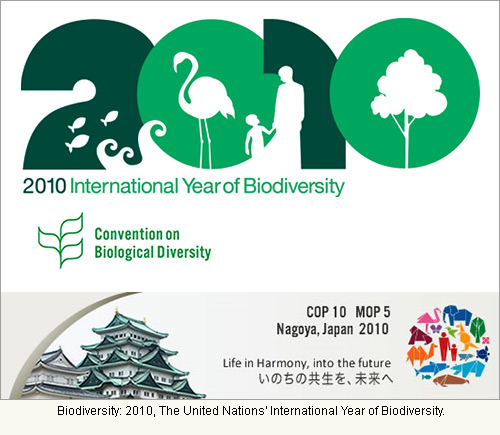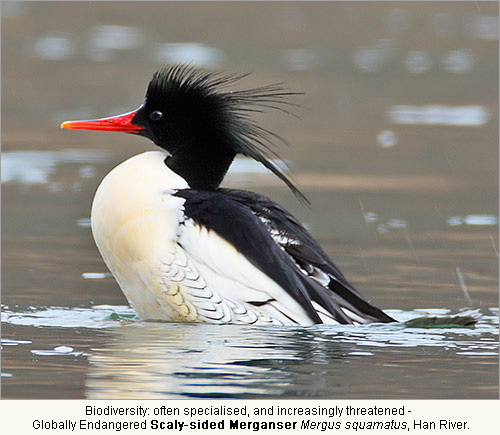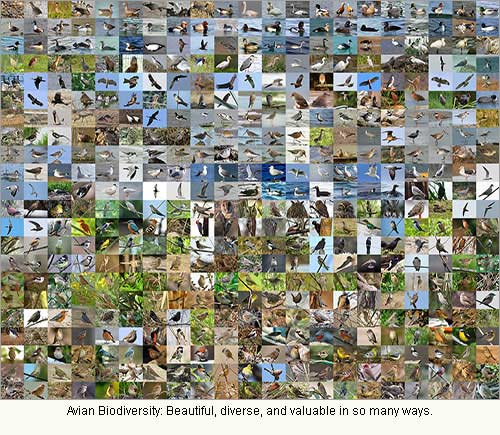This Update covers October 1st to December 31st 2009. It is in three parts:
While every year is important in its own way, 2010 has special meaning for all who care for birds and other species, for biodiversity. Starting on January 11th, 2010 becomes the United Nations-designated “International Year of Biodiversity” (UN General Assembly Resolution 61/203). It is also the year identified in the Environmental Sustainability Targets of the Millennium Development Goals by which “rates of biodiversity loss need to be reduced” (See: http://www.undp.org/mdg/goal7.shtml ), and new targets need to be set; and it is the year in which the Tenth Conference of the Parties of the Convention on Biological Diversity will be held in Japan in October (http://www.cbd.int/cop10).
2010 can therefore be the year in which concerns for biodiversity loss (i.e. the decline and extinction of species and the systems which maintain life) move much closer to the centre stage of global awareness and political action. Such concern and action are as warranted as they are urgent. As described by the IUCN, “We are facing a serious crisis in biodiversity, the elaborate network of animals, plants, and the places where they live on the planet. And when we talk of animals, we also mean humans”. (http://www.iucn.org/what/biodiversity).
Regrettably, the central importance of species’ conservation to sustainable development, and to climate change adaptation and mitigation, is often ignored. Biodiversity is of course both the life of and in the forest; it is the web of life in the seas, the tidal-flats, the rivers, the grasslands, on mountain tops and in the sky. Biodiversity helps to create and maintain the atmosphere which we breathe; naturally helps to purify the water that we drink and otherwise depend on in so many other ways; and it is biodiversity that contains the species that we eat, either taken directly from the wild or through agriculture, aquaculture and mariculture. Biodiversity is therefore as essential to human life and well-being as the air that we breathe. And yet we continue to neglect, undervalue and destroy it.
The 2009 IUCN annual review of global biodiversity confirms that already “a third of the world’s amphibians, a fifth of all mammals and 70% of all plants are under threat” (UNEP, 2009), while 1227 (or 12.4%) of all bird species are also now considered threatened with extinction. At present, 192 bird species are classified as Critically Endangered, meaning they are at imminent risk of global extinction (http://www.birdlife.org/action/science/species/global_species_programme/red_list.html).
Only one of these Critically Endangered species is found annually in Korea: the Spoon-billed Sandpiper Eurynorhynchus pygmeus. This is a charismatic and highly-specialised shorebird with a global population that has declined from an estimated 2000-2800 pairs in the 1970s, to less than 1000 pairs in 2000, to between 150 and 450 pairs in 2007 (Zockler & Syroechkovskiy, 2008/2010), down to between only 130 and 200 pairs by 2009 (http://10000birds.com/spoon-billed-sandpiper-part-two-interview-with-christoph-zckler.htm).
Like most species, the Spoon-billed Sandpiper is (poorly-known yet) rather predictable. It feeds only on a narrow range of foods, and it depends on its habitat differently to other species. Like other species, it also responds to changes to that habitat – either increasing if the habitat becomes more suitable or declining if the habitat becomes worse. Like many species, the Spoon-billed Sandpiper is therefore a very valuable and honest bio-indicator, as changes in its population and distribution reveal changes to the environment that we might otherwise miss or choose to ignore. Many such changes are critical to our own species, to our health, culture and economy. Declines indicate the degradation of ecosystems. And extinction reveals that whole habitats are being lost.
“Several hundred” Spoon-billed Sandpiper were formerly counted in the Nakdong Estuary (Gore and Won, 1971), before estuary dam construction in the late 1980s. A peak of only four was counted there in 2009. 280 were reported at Saemangeum on southward migration in the late 1990s (Barter, 2002). A single flock of 31 (which would now represent almost 10% of the remaining global population) was last found at Saemangeum as recently as late May 2007 (Moores et al. 2007). This was one year after the Saemangeum seawall started to kill off most of the tidal-flow and the benthic life on which the Spoon-billed Sandpiper and many other species, including local fishing communities, depended. None were seen at Saemangeum during the whole of 2009 – presumably the first year in millennia that the species has not been present there.
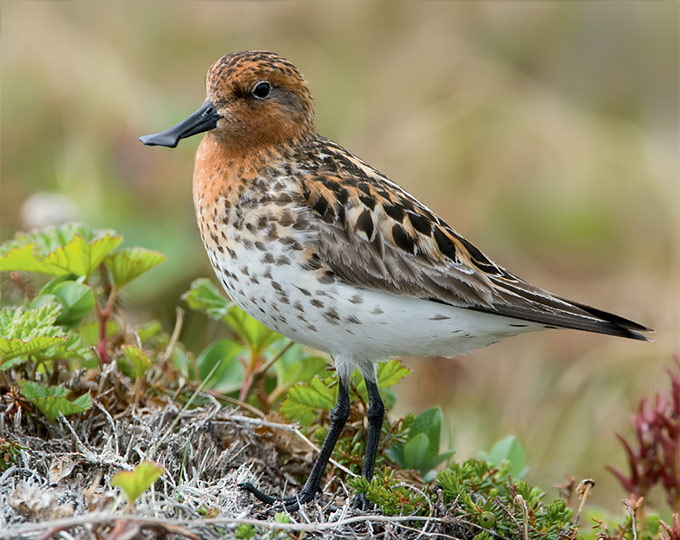
Although the Spoon-billed Sandpiper is also suffering from disturbance and degradation of its Arctic-breeding areas (due to human-induced climate change), in addition to hunting in some areas, the International Single Species Action Plan for the species identifies tidal-flat reclamation and degradation as the main threat to its survival (Zockler & Syroechkovskiy, 2008/2010). With the Saemangeum seawall closed; with the Nakdong Estuary suffering the impacts of barrage closure, reclamation and infrastructure development (and now further threatened by changes in river-use due to the Four Rivers project); and with most other potential sites nationwide lost to the species, the future for the Spoon-billed Sandpiper in the Republic of Korea is bleak. That is, unless existing obligations held under international agreements and conventions are urgently and properly honoured.
The threats to the estuaries and tidal-flats used by the Spoon-billed Sandpiper and other biodiversityare not only within Korea of course. Sites used in China, Viet Nam, all along the Flyway have been degraded or reclaimed in recent decades. One of the last remaining wintering areas for the species is Sonadia Island in Bangladesh, where eight Spoon-billed Sandpiper were counted in January 2009. Even though an alternative development site exists, Sonadia is now targeted for the proposed development of a deep water sea-port, which as intended will be funded by international donors. The first phase of construction would be completed by 2016 and the full development finished by 2055. If constructed, the port would drastically change the habitats used by Spoon-billed Sandpiper, sea turtles, and cetaceans, also threatening mangroves and the marine resources of an area depended on by “hundreds of thousands of community people” (Spoon-billed Sandpiper Recovery Team News Bulletin No. 3, December 2009).
Although declines and even extinction can be driven by natural forces, the rate of extinction is accelerating rapidly, due largely to the rising human population, increasing rates of consumption, and large-scale unsustainable development projects, as at Saemangeum and as proposed at Sonadia Island. The evidence of habitat degradation and loss, the life-threatening cost of present development models, is all around us if we care to look – even through the windows of our homes, our offices, and our cars. It can be seen in the concrete of cities and roads, in the grey horizons and hazy skies. In many parts of the world, including here in Korea, it can even be heard in the growing silence of the seasons.
Economic growth is seen as more or less synonymous with present models of development. If a nation maintains annual economic growth of 5%, then its economy will have more than doubled in size in only twenty years, providing a better quality of life for many. Over a human lifetime of 70 years, the same 5% annual growth, however, would mean that the economy, the amount a nation consumes and produces, will have grown 30 times larger; and by the end of a century, more than 130 times. On a crowded and already resource-stretched planet, is such growth possible or even desirable? Already, it has led to massive declines in marine life and health, a changing climate, and what has been described as an “Extinction Crisis” (Bräutigam and Jenkins, 2001).
Unsurprisingly, humanity’s Ecological Footprint already far exceeds the Earth’s capacity. We are, as individuals and as a species, consuming more than the Earth can produce or regenerate. We are no longer living off the interest. Rather, we are using up the Earth’s “life-savings”. This is clearly not sustainable or wise.
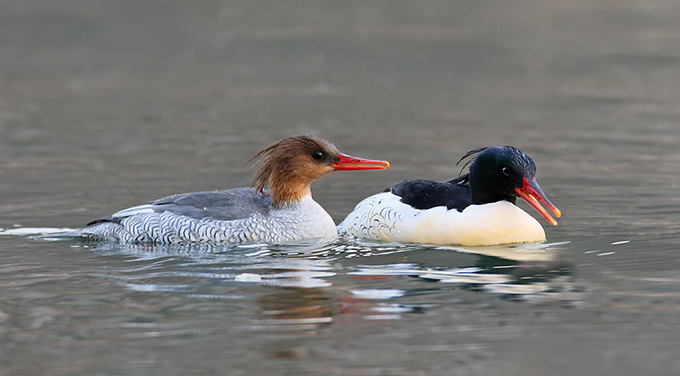
However, rather than modifying the development model to focus on quality of life and genuine sustainability (as called for through the Millennium Development Goals), destructive mega-projects continue to be proposed, increasingly packaged as “green” or “environmentally friendly”.
For example, construction of a city at Song Do in Incheon has already required the reclamation of several thousands of hectares of internationally important wetland. While proposing the designation of some remaining tidal-flats as Wetland Conservation Areas, Incheon City still aims to convert into land the most important remaining area of wetland, an area that supports 13 or more species of waterbird in Ramsar-defined internationally important concentrations. Despite the loss of biodiversity this will cause, Song Do city is still being promoted domestically and internationally as an Eco-city worthy of international accreditation.
Even the construction of 16 new dams and the dredging of 700 km of river as part of the Four Rivers project have been re-packaged as “restoration”. River restoration is indeed needed here in the Republic of Korea. It could be achieved, as in other nations, through the removal of dams and concrete banks, and through the set-aside of large areas of low-lying land to absorb seasonal flooding. Such restored floodplain wetlands would produce numerous benefits. They would improve water quality, reduce downstream flooding, increase water storage, help to conserve biodiversity, and provide beautiful areas for people to visit.
Based in science and an understanding of biodiversity and ecosystem functions, large-scale habitat restoration of this kind will increasingly become a vital tool in reducing humanity’s Ecological Footprint, helping species to increase while for example reducing the threat of human-induced climate change.
The Four Rivers project, however, is not a restoration project. We believe that the Four Rivers project will cause major declines in many species that are ecologically dependent on rivers. These include the Mandarin Duck Aix galericulata (based on Ministry of Environment data, a species that is already declining rapidly at the national level: MOE 2004, 2005, 2006, 2007 and 2008) and the globally Endangered Scaly-sided Merganser Mergus squamatus.
Depictions of the rivers as proposed after “restoration” produced by the main ministry driving the Four Rivers project try to tell a very different story. Display panels in Mokpo city of the restored Yeongsan River depict boardwalks running alongside a narrow river. While the Four Rivers promises to make several rivers uniformly deep through dredging, this image shows a shallow river with rich wetland vegetation on one side. In the river, close to families of smiling passers-by, swim several usually wary Whooper Swans Cygnus cygnus, apparently undisturbed by the massive increase in disturbance. Next to the swans, stand several Eurasian White Storks Ciconia ciconia, a species as yet not recorded reliably in the wild in Korea or East Asia. In the far background, flying over blooming cherry trees, is a flock of Flamingo. This is a family of species typically dependent on highly saline shallow wetlands, not rivers, none of which have ever been recorded in the wild in East Asia!
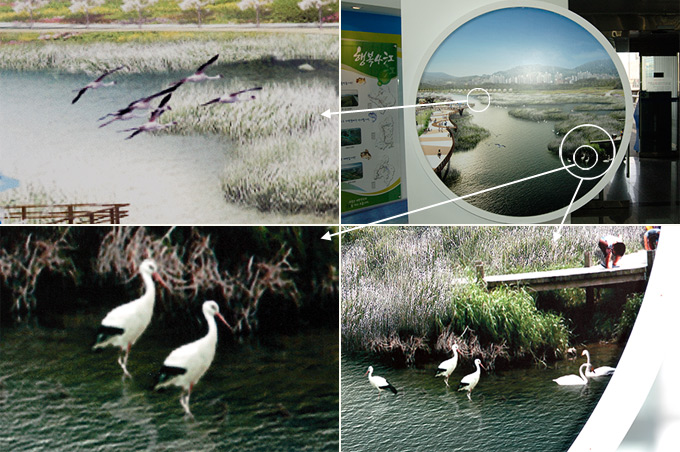
These depictions are as absurd as they are unscientific. And they reveal the very low levels of concern felt by many for biodiversity.
If biodiversity conservation is so falsely portrayed, how is it possible for anybody to believe any of the other claims connected to these developments?
Clearly, we need to use this International Year of Biodiversity to help improve the situation.
As all of our members know, Birds Korea is a specialised, non-political organisation dedicated to the conservation of birds and their habitats, in Korea and the wider Yellow Sea Eco-region. We work to provide, to import and to export, best information, honestly.
In addition to our usual work, in 2010:
We will open our bilingual gallery of the birds of Korea, containing almost two thousand images, helping to reveal the beauty and diversity of almost 500 of Korea’s bird species;
As part of the Spoon-billed Sandpiper Recovery Team, we will continue our work for the Critically Endangered Spoon-billed Sandpiper and through survey and literature review we will provide materials on other globally threatened bird species, including the Scaly-sided Merganser. All such work will aim to raise awareness of biodiversity conservation, as a central part of Sustainable Development, and encourage a shift in conservation policy and priorities.
We will continue to promote genuine and well-proven restoration and habitat enhancement approaches, as at the Mokpo Namhang Urban Wetland, and through other projects (in e.g. Busan and Incheon).
And we will continue with the development of the Birds Korea Blueprint for the Conservation of Avian Biodiversity. The Blueprint will close numerous information gaps on species’ distribution, identify population trends in selected species, and through Case Studies examine the strengths and weaknesses of existing conservation initiatives. This report will then be published online and (funds allowing) in hard copy, in time for distribution at the Convention on Biological Diversity conference in October. More details will be provided online and in updates in the coming weeks and months.
2010: a year that is full both of challenge and promise for biodiversity. As always, we welcome your participation and ideas, and thank you for your continuing support!
References:
- Barter, M. 2002. Shorebirds of the Yellow Sea: importance, threats and conservation status. Wetlands International Global Series 9, International Wader Studies 12. Canberra, 104 p.
- Bräutigam A. & M. Jenkins. 2001. The Red Book: the Extinction Crisis Face to Face. Published by CEMEX in collaboration with IUCN’s SSC and Agrupacion Sierra Madre.
- Gore, M. E. J. and Won, Pyong-Oh 1971. Birds of Korea. Seoul: Royal Asiatic Society.
- Ministry of Environment. 1999-2004, 2005, 2006, 2007, 2008. Winter Bird Census.
- Moores, N., Rogers, D., Koh C-H., Ju Y-K, Kim R-H and Park M-N. 2007. The 2007 Saemangeum Shorebird Monitoring Program Report. Published by Birds Korea, Busan.
- UNEP. 2009. Extinction crisis shows urgent need for action to protect biodiversity. United Nations Environment Program, Press Release, November 3rd, 2009. Accessed December 2009, at: http://www.unep.org/Documents.Multilingual/...DocumentID=602&ArticleID=6360
- Zockler C. & E. Syroechkovskiy. 2008/2010. International Single Species Action Plan for the Conservation of the Spoon-billed Sandpiper (Eurynorhynchus pygmeus). Series Editor Simba Chan. Published by Convention on Migratory Species & BirdLife International). Accessed Dec. 2009, at: http://www.arccona.org/download/CMS Spoon-billed Sandpiper Action Plan final Nov 2008.pdf
As always, we remain extremely busy in all areas of our work, which includes Research, Planning and Design, and Awareness Raising and Education. Day to day, this work ranges from “hands-on” and local, like holding a fund-raising bazaar in Busan (see: http://www.birdskorea.or.kr/Forum/BirdsKorea/5737), to online and international, with the opening of a Facebook site for Birds Koreans living in North America.
As we continue to grow, we need more members (especially “Monthly Members”), more people who enjoy networking and organising events, more field workers, artists, fund-raisers, translators and teachers … You do not need to be a bird expert. But we do need more people of good mind who care for Korea, who care for biodiversity, and who care for the future. Please read on and think of ways in which you can get more involved …
In the last three months of 2009 our work included:
Research
Research for the Birds Korea Blueprint has continued. This has included counts of migrants on Gageo and Socheong Islands (to detect population trends where possible), survey work on Black Woodpigeon (several territories of which are threatened by road construction plans on Gageo Island), counts of seabirds at sea, and counts of all birds at the Mokpo Namhang Urban Wetland. In addition, we are now gathering information on waterbirds that depend on the nation’s river systems, as part of a short paper we will produce looking at the anticipated impacts of the Four Rivers project.
Planning and Design
Birds Korea has been working for the conservation of the 50 hectare Mokpo Namhang Urban Wetland since 2007, conducting bird counts, data analysis, and holding several educational and public awareness activities. Funded by the UNDP-GEF YSLME project, we invited other experts to help assess the site in 2008, and produced guidelines for its restoration. During 2009, infilling restarted of the already impounded P2 and P3, the area used by the majority of waterbirds, and Mokpo City has now proposed several alternative end-uses for these two sections, including a waterfront park and an industrial and housing area. A final proposal was to be released before the end of 2009. To date, all the proposals for the wetland that we have reviewed will lead to a loss of biodiversity, and we believe will create an area of relatively low value for citizens.
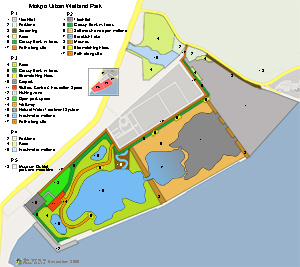
© Birds Korea
We therefore held two meetings in Mokpo City in early November with selected decision-makers in Mokpo City council and Mokpo KFEM. Following discussion on a range of issues, and in the understanding that the infilling will continue, we have now produced a basic design for the wetland, which entails the development of the “Mokpo Urban Wetland Park”. As we propose, within P2 and P3 the park should include a small education centre, enhanced wetland areas, a natural water treatment area, and earth banks to reduce disturbance to sensitive areas. Areas for use by local walkers and recreational fishers, both present users of the site, should also be enhanced. Improved management approaches should be developed for P1 and P4, and the whole park should be promoted both for its biodiversity value and for its proximity to the already excellent museum and culture district of Mokpo City.
As proposed, we believe that the Mokpo Urban Wetland Park would enhance biodiversity values, improve water quality, and greatly increase the educational and recreational potential of the site. We believe that the Park would be an exceptional asset for the city, helping to establish Mokpo City as a local government leader in wetland conservation, while providing multiple benefits for both birds and people.
Due to schedule differences through December, it proved too difficult to arrange a hoped-for meeting with the Mayor of Mokpo City to explain the park proposal directly. We therefore submitted the basic design for the Mokpo Urban Wetland Park to the Mayor’s office by post on December 21st, and shared the plan with media on December 23rd/24th. Media coverage was, as expected, very positive.
Awareness-raising and Education
We are very pleased to report that each year our conservation message is reaching a larger and larger audience, through our highly-respected websites, and through positive media coverage, presentations and meetings, and through collaboration with key organisations.
During the last three months of 2009, for example, our English-language website averaged 838 unique visitors per day from a total of 150 countries. The most visited pages were Bird News, Saemangeum and articles on the Grand Canal/Four Rivers. Due to a software difficulty, we do not have similar data on the Korean-language website. However, articles and information from the site are also increasingly being reproduced in online articles, and hits are increasing steadily. Clearly, we are reaching more than only our members!
Media coverage during the period has included online Science magazine, in response to the plan to conserve the DMZ (http://blogs.sciencemag.org/scienceinsider/2009/12/conservationist.html), the Jeju Weekly, on a proposed cable car (http://www.jejuweekly.com/news/articleView.html?idxno=456), and the Yeonhap News and other media outlets on the Mokpo Urban Park plan (http://www.yonhapnews.co.kr/economy/2009/12/24/0302000000AKR20091224127400054.HTML (in Korean)).
In addition, we are a domestic focal point for SAVE International’s work for the conservation of Black-faced Spoonbill Platalea minor at Song Do, including for their mass mailing on December 10th (to specialists, NGOs and media in the United States of America and beyond). We are also active members of the World Wetlands Network (WWN), ensuring that our opinions on the Four Rivers were very well-represented by the WWN letter of December 11th (which received significant domestic media coverage).
While Birds Korea was present at the First Joint Workshop on the Memorandum of Understanding Wadden Sea-Korea (Mokpo City, October 19th-20th) and at the Changwon Declaration meeting (Changwon City, November 18th), we also had several opportunities to present on our work. This included a lecture to students by our National Coordinator Ms Park Meena at Shilla University in Busan (October 22nd: http://www.birdskorea.or.kr/Forum/Events/5706) and a presentation on the Birds Korea Blueprint and the Mokpo Namhang Urban Wetland by our Director Mr. Nial Moores, at the East Asia Seas Congress in Manila, the Philippines, on November 24th.
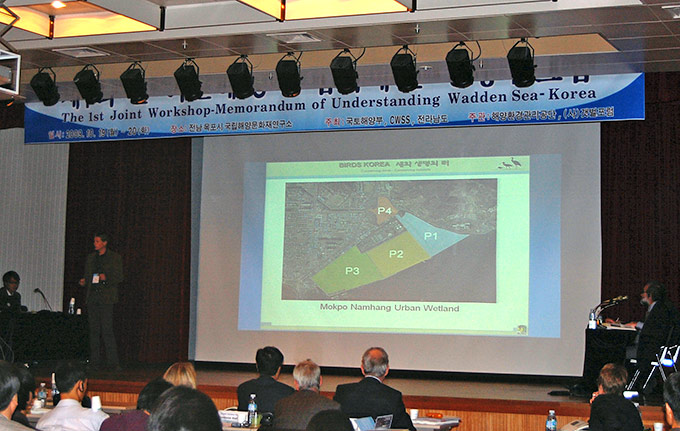
Birds Korea in North America
It usually takes a long time for grassroots organisations like Birds Korea to spread their roots. However, we already have a large number of overseas members and we are delighted to include this message (dated December 16th) from our Formal Advisor in Canada on the growing capacity of Birds Korea in North America (a model for Birds Korea on other continents?):

Hello from Canada!
I am proud to be writing as a Birds Korean in North America, where our group is expanding in a few ways. A growing group of Birds Koreans in both Canada and the United States of America are working together to share news and raise public awareness about Birds Korea and Korean bird-conservation issues across North America. In order to do this more effectively, we have created a Birds Korea-North America Facebook page (search 'Birds Korea'), where we are always looking for more 'fans' to join Birds Korea, add to our discussions on the Facebook page, spread the news to their friends and contribute photos to the photo gallery. We have also applied for two grants to help raise funds for the Blueprint for the Avian Biodiversity of the Yellow Sea Eco-region. Our Education Team is also beginning the process of writing an Environmental Education book that will be written in English to be made available in the Republic of Korea.
If you are interested in joining our growing team, there are many choices for you; fundraising, gathering information, building connections between Birds Koreans across North America and the Republic of Korea, helping with translation, and other ideas you have that we haven't thought of yet! Please email me at geoff.styles@birdskorea.org if you wish to join us or just have questions or thoughts you'd like to share.
Our message is growing both within the Republic of Korea and across North America - the world is one. Help us spread that message and work towards an environmentally sustainable future both in Korea and across Canada and the United States of America. Have a wonderful start to your New Year!
Geoff Styles, Formal Advisor, Birds Korea-Canada
Birds Korea: finding ways to conserve birds and their habitats, for a better future for us all.
The following are exceptional observations made by Birds Koreans and from a collation of records by other observers posted on other leading birding websites, mostly especially the websites of the National Parks Migratory Bird Research Centre, KWBS and BirdDB. Nomenclature, order and status codes follow The Birds Korea Checklist (2009).
Mute Swan Cygnus olor W5
13 were seen on December 20th by Barry Heinrich and Kim Seong-Mi at Songji lagoon near Sokcho, Gangwon Province
Black-faced Spoonbill Platalea minor EN, S4/3 W5
A survey conducted by KWBS members from 16th-18th October found 572 individuals at a total of twenty sites.
Grey-faced Buzzard Butastur indicus P3, S5
3600 counted moving through Gageo Island, Shinan County, Jeollanam Province, on October 6th by Nial Moores is a new national high day count.
Steppe Eagle Aquila nipalensis V2
Two, a Third Calendar-year and a subadult, seen together on Socheong Island, Ongjin County, Incheon, on November 3rd is approximately the 8th record for the Republic of Korea.
Saker Falcon Falco cherrug EN, V1
One seen on Socheong Island by Nial Moores on October 21st, with the same or a different individual seen on October 23rd, is the first record for the island and only the 12th or 13th record for the Republic of Korea.
Hooded Crane Grus monacha VU, P3/W4
KWBS members counted 4500 in total at nine different sites between October 25th-30th.
Spoon-billed Sandpiper Eurynorhynchus pygmeus CR, P5
One juvenile photographed, apparently on Jeju Island, was posted in early October on the Birds in Jeju website. Further details are presently unavailable. Three were seen on Yubu Island, Geum Esuary on October 5th by Jong Jin Mun (KWBS website) with the last record of the year one still there on October 18th Park Joo-Hyun (BirdDB).
Black-legged Kittiwake Rissa tridactyla P2 W3
A count of 6300 off Socheong Island on November 2nd by Nial Moores is the highest national day count.
Eurasian Collared Dove Streptopelia decaocto V1, NN2
One photographed in early October and posted on BirdDB.com (details withheld), and another photographed in Cheorwon by Kwak Ho-Kyoung on November 29th become only the third or fourth records of the year, and approximately the tenth and eleventh national records since 1961.
White-bellied Green Pigeon Treron sieboldii V1
A belated record is of one photographed on Chilbal Island, Shinan County, by Park Jong-Gil on September 30th.
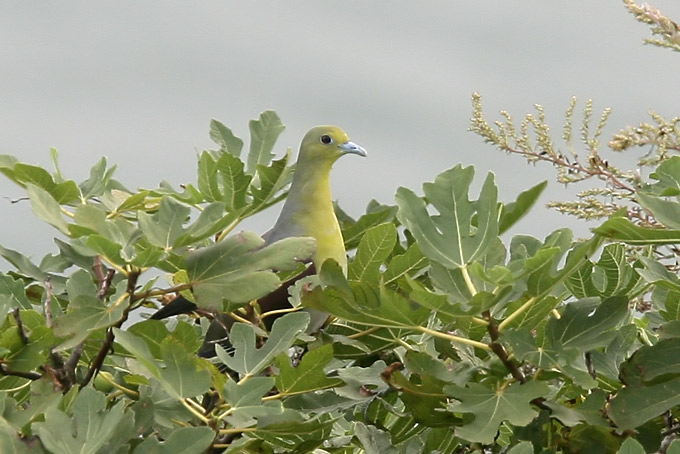
Red-backed Shrike Lanius collurio V2
One or two juveniles, found and photographed on Gageo Island by Nial Moores in late September, remained on-site until at least October 5th.
Long-tailed Shrike Lanius schach V1
Two seen on Heuksan Island, Shinan County, by Robin Newlin on October 16th have apparently been present for several months (via Park Jong-Gil), while two have also apparently been over-summering in western Jeju. One at Joonam Reservoir from late November (via Mo In-Ho) is an exceptional record for the far southeast.
Great Grey Shrike Lanius excubitor V2
One juvenile, assigned to the subspecies sibiricus (a taxon previously unrecorded in Korea), was photographed on Socheong Island by Nial Moores on October 24th. This is the 7th record for the Republic of Korea, and also the first Korean record of the species in October.
Northern Raven Corvus corax
One seen and poorly photographed on Socheong Island by Nial Moores on October 21st is the first record for the Republic of Korea. There are three previous records of this species from northernmost DPRK.
Yellow-bellied Tit Periparus venustulus V1
Since the first record in October 2005, the species has been found with increasing regularity. There were seven records in the first half of the year (including two on the East coast), and at least half-a-dozen further records in the period under review, with birds either banded (Heuksan Island), photographed (Bigeum Island, Shinan County and Namhansan Park, Seoul) or sound-recorded (Socheong Island).
Asian Short-toed Lark Calandrella cheelensisV2
One was seen and photographed on Socheong Island from October 16th-24th by Nial Moores, followed soon after by two or three on Hong Island, Shinan County, on October 22nd (National Parks office), and another on Heuksan Island from October 24th – when very well-photographed by Park Jong-Gil. This individual remained until at least November 1st. Another was then found and photographed on Gageo Island by Nial Moores on November 17th & 18th, with a further individual reported near Hwasun in the southwest of Jeju Island presumably in December (via Matt Poll).
There are probably only two previous records of this species in Korea within the past decade, and fewer than five previous records, despite large numbers claimed in some literature.
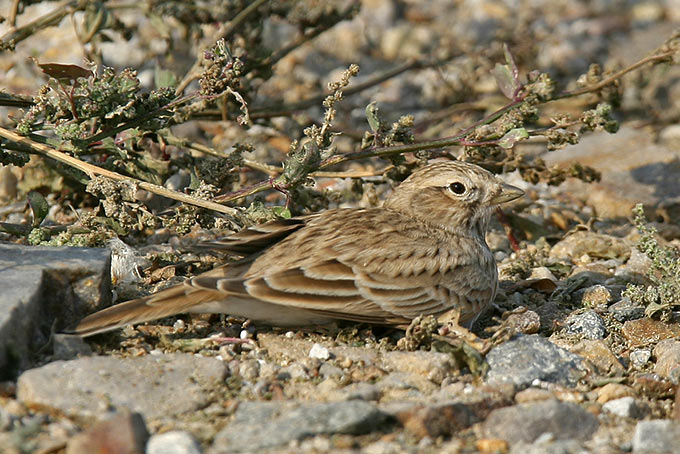
Yellow-streaked Warbler Phylloscopus armandii V1 (Category 3)
One found on Socheong Island on October 26th by Nial Moores and Marc van Roomen is the fourth national record (all from Socheong) and the first record supported by photographs. As such the species will be moved to Category One in the next Birds Korea Checklist Update.
Guldenstadt's Redstart Phoenicurus erythrogastus
One First-winter male was seen at close range, though incompletely, on Gageo Island by Robin Newlin on October 16th. Unfortunately no photographs or sound recordings were obtained. As the species has previously not been recorded in Korea, a fuller description has been requested, and after further review it is fully expected that the species will be added to Category 3 of the Birds Korea Checklist in the next Update.
Desert Wheatear Oenanthe deserti V2
One photographed on Gageo Island by Nial Moores on October 5th is only the third record for Korea, after the first in 2008.
Red-breasted Flycatcher Ficedula parva V1
At least five records in October and November:
- One was photographed and sound-recorded in the south-east of Socheong Island on October 19th (Nial Moores).
- One seen in the centre of Socheong Island on November 2nd (Robin Newlin), being heard in the same area on November 3rd (Nial Moores).
- One was photographed and sound-recorded near the school on Socheong Island (1-maul) on November 6th (Nial Moores).
- One was photographed at North Point, Socheong Island on November 8th (Nial Moores).
- One was seen and heard on Gageo Island on November 16th (Nial Moores).
There have now been at least 14 records of the species since the first in late April 2003.
Verditer Flycatcher Eumyias thalassinus V2
One photographed on Gageo Island by Nial Moores on November 18th is only the 7th record for Korea.
Previous records:
- One, Gageo Island, October 2001.
- One, Socheong island, November 2nd, 2003.
- One, Hong Island, November 2nd, 2004.
- One, Jeju Island, November 27th, 2004.
- One male, Hong Island, September 23rd/24th, 2005.
- One First-winter female, Hong Island, September 29th-Oct 5th 2005.
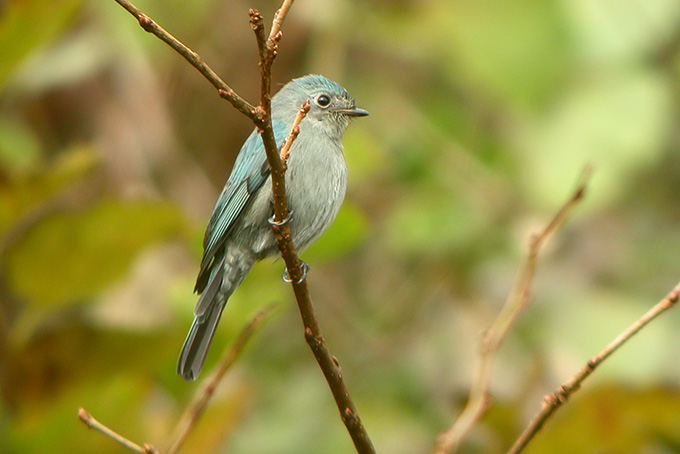
Scaly-breasted Munia Lonchura punctulata V2
A party of six, photographed at Seogwipo, Jeju, by Matthew Poll on November 14th is the fourth record for Korea, after the first three records in late October 2003.
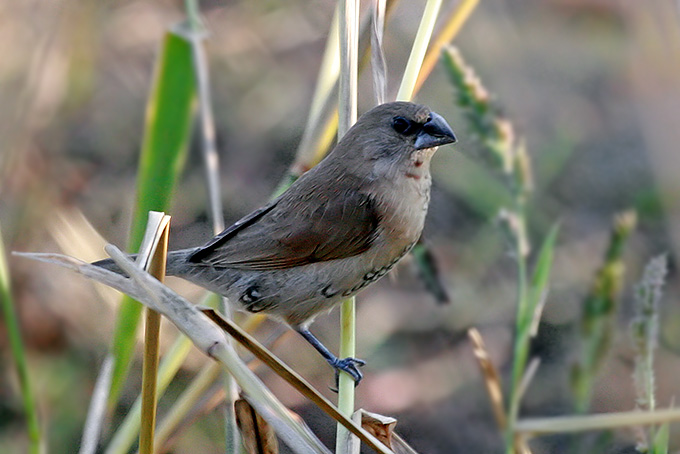
Finally, a gentle reminder to all of our members (past and present) living in Korea. Birds Korea depends entirely on the support of our members and volunteers. Donations and domestic membership fees are vital to us! Please renew your membership and help us to help the birds!
This update was prepared through the joint efforts of Nial Moores, Kim Sona, Andreas Kim, Park Meena, Geoff Styles, Lim Yeoyoung, and Tim Edelsten, with contributions by many members.
Birds Korea, December 27th 2009.




